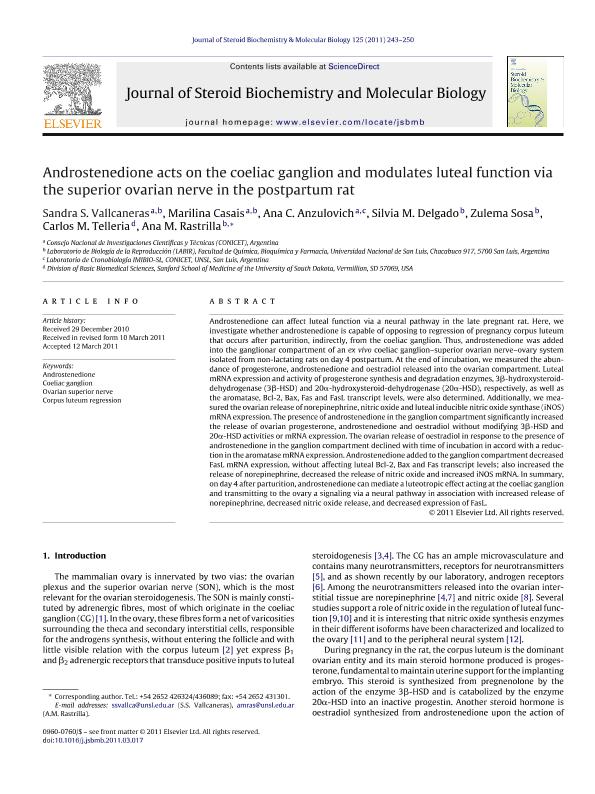Mostrar el registro sencillo del ítem
dc.contributor.author
Vallcaneras, Sandra

dc.contributor.author
Casais, Marilina

dc.contributor.author
Anzulovich Miranda, Ana Cecilia

dc.contributor.author
Delgado, Silvia M.
dc.contributor.author
Sosa, Zulema
dc.contributor.author
Telleria, Carlos Marcelo

dc.contributor.author
Rastrilla, Ana M.
dc.date.available
2017-03-31T14:30:54Z
dc.date.issued
2011-07
dc.identifier.citation
Vallcaneras, Sandra; Casais, Marilina; Anzulovich Miranda, Ana Cecilia; Delgado, Silvia M.; Sosa, Zulema; et al.; Androstenedione acts on the coeliac ganglion and modulates luteal function via the superior ovarian nerve in the postpartum rat; Elsevier; Journal of Steroid Biochemistry and Molecular Biology; 125; 3-5; 7-2011; 243-250
dc.identifier.issn
0960-0760
dc.identifier.uri
http://hdl.handle.net/11336/14578
dc.description.abstract
Androstenedione can affect luteal function via a neural pathway in the late pregnant rat. Here, we investigate whether androstenedione is capable of opposing to regression of pregnancy corpus luteum that occurs after parturition, indirectly, from the coeliac ganglion. Thus, androstenedione was added into the ganglionar compartment of an ex vivo coeliac ganglion–superior ovarian nerve–ovary system isolated from non-lactating rats on day 4 postpartum. At the end of incubation, we measured the abundance of progesterone, androstenedione and oestradiol released into the ovarian compartment. Luteal mRNA expression and activity of progesterone synthesis and degradation enzymes, 3β-hydroxysteroid-dehydrogenase (3β-HSD) and 20α-hydroxysteroid-dehydrogenase (20α-HSD), respectively, as well as the aromatase, Bcl-2, Bax, Fas and FasL transcript levels, were also determined. Additionally, we measured the ovarian release of norepinephrine, nitric oxide and luteal inducible nitric oxide synthase (iNOS) mRNA expression. The presence of androstenedione in the ganglion compartment significantly increased the release of ovarian progesterone, androstenedione and oestradiol without modifying 3β-HSD and 20α-HSD activities or mRNA expression. The ovarian release of oestradiol in response to the presence of androstenedione in the ganglion compartment declined with time of incubation in accord with a reduction in the aromatase mRNA expression. Androstenedione added to the ganglion compartment decreased FasL mRNA expression, without affecting luteal Bcl-2, Bax and Fas transcript levels; also increased the release of norepinephrine, decreased the release of nitric oxide and increased iNOS mRNA. In summary, on day 4 after parturition, androstenedione can mediate a luteotropic effect acting at the coeliac ganglion and transmitting to the ovary a signaling via a neural pathway in association with increased release of norepinephrine, decreased nitric oxide release, and decreased expression of FasL.
dc.format
application/pdf
dc.language.iso
eng
dc.publisher
Elsevier

dc.rights
info:eu-repo/semantics/openAccess
dc.rights.uri
https://creativecommons.org/licenses/by-nc-nd/2.5/ar/
dc.subject
Androstenedione
dc.subject
Coeliac Ganglion
dc.subject
Ovarian Superior Nerve
dc.subject
Corpus Luteum Regression
dc.subject.classification
Otras Ciencias Médicas

dc.subject.classification
Otras Ciencias Médicas

dc.subject.classification
CIENCIAS MÉDICAS Y DE LA SALUD

dc.title
Androstenedione acts on the coeliac ganglion and modulates luteal function via the superior ovarian nerve in the postpartum rat
dc.type
info:eu-repo/semantics/article
dc.type
info:ar-repo/semantics/artículo
dc.type
info:eu-repo/semantics/publishedVersion
dc.date.updated
2017-03-30T17:42:40Z
dc.journal.volume
125
dc.journal.number
3-5
dc.journal.pagination
243-250
dc.journal.pais
Países Bajos

dc.journal.ciudad
Ámsterdam
dc.description.fil
Fil: Vallcaneras, Sandra. Universidad Nacional de San Luis. Facultad de Química, Bioquímica y Farmacia. Departamento de Bioquímica y Ciencias Biológicas. Laboratorio de Biología de la Reproducción; Argentina. Consejo Nacional de Investigaciones Científicas y Técnicas; Argentina
dc.description.fil
Fil: Casais, Marilina. Universidad Nacional de San Luis. Facultad de Química, Bioquímica y Farmacia. Departamento de Bioquímica y Ciencias Biológicas. Laboratorio de Biología de la Reproducción; Argentina. Consejo Nacional de Investigaciones Científicas y Técnicas; Argentina
dc.description.fil
Fil: Anzulovich Miranda, Ana Cecilia. Consejo Nacional de Investigaciones Científicas y Técnicas. Centro Científico Tecnológico San Luis. Instituto Multidisciplinario de Investigaciones Biológicas de San Luis; Argentina. Universidad Nacional de San Luis; Argentina
dc.description.fil
Fil: Delgado, Silvia M.. Universidad Nacional de San Luis. Facultad de Química, Bioquímica y Farmacia. Departamento de Bioquímica y Ciencias Biológicas. Laboratorio de Biología de la Reproducción; Argentina
dc.description.fil
Fil: Sosa, Zulema. Universidad Nacional de San Luis. Facultad de Química, Bioquímica y Farmacia. Departamento de Bioquímica y Ciencias Biológicas. Laboratorio de Biología de la Reproducción; Argentina
dc.description.fil
Fil: Telleria, Carlos Marcelo. University of South Dakota; Estados Unidos
dc.description.fil
Fil: Rastrilla, Ana M.. Universidad Nacional de San Luis. Facultad de Química, Bioquímica y Farmacia. Departamento de Bioquímica y Ciencias Biológicas. Laboratorio de Biología de la Reproducción; Argentina
dc.journal.title
Journal of Steroid Biochemistry and Molecular Biology

dc.relation.alternativeid
info:eu-repo/semantics/altIdentifier/url/http://www.sciencedirect.com/science/article/pii/S0960076011000689
dc.relation.alternativeid
info:eu-repo/semantics/altIdentifier/doi/http://dx.doi.org/10.1016/j.jsbmb.2011.03.017
Archivos asociados
